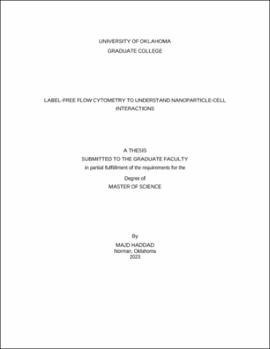| dc.description.abstract | Understanding nanoparticle-cell interactions at single-nanoparticle and single-cell resolutions is crucial to improving the design of next-generation nanoparticles for safer, more effective, and more efficient applications in nanomedicine. This study partly focuses on recent advances in the continuous high-throughput analysis of nanoparticle-cell interactions at the single-cell level. We highlight and discuss the current trends in continual flow high-throughput methods for analyzing single cells centered around flow cytometry techniques. This study further discusses the challenges and opportunities with current flow cytometry approaches and provides proposed directions for innovation in the high-throughput analysis of nanoparticle-cell interactions.
With the information obtained from the investigation of the single-cell analysis methods, it was clear than such analysis methods at the single-cell level are necessary to understand cell behavior and nanoparticle-cell interactions. However, current methods, such as inductively coupled plasma mass spectrometry and microscopy, have some disadvantages, such as being labor-intensive and can affect nano-bio interactions. Therefore, we used flow cytometry (FCM) as a label-free technique to enhance our knowledge of nanoparticle-cell interactions. To understand how 100 nm gold nanoparticles (AuNPs) affect cellular behavior, we incubated the NPs with RAW 264.7 cells to examine the change in granularity. Upon confirming this change, we wanted to investigate how using different nanoparticles and cell types can impact nano-bio interactions. Our results show that larger nanoparticles increase the side scattering (SSC) readings, hence the complexity of cells. Next, we performed a kinetics analysis experiment to understand how the uptake of NPs influences cells over a period of 24 hrs. We found that NP uptake increases with time but reaches a plateau at higher NP concentrations towards the end of the investigation period. Additionally, we investigated if the endocytosis pathway for Heparosan (HEP)-coated 100 nm AuNPs can be determined. Despite using inhibitors from different pathways, we have not been able to confirm which pathway HEP-coated 100 nm AuNPs get uptaken by. | en_US |
